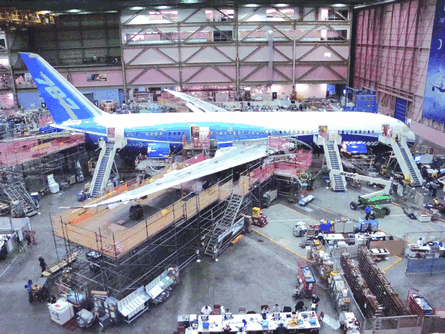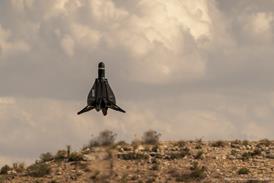Assembly of the delayed fourth flight-test Boeing 787 is poised to start following delivery to the Everett line near Seattle of the final two outstanding structural sections.
Delivery had been delayed by five weeks after the 25.6m (84ft)-long centre fuselage barrel was damaged in a production incident. Boeing opted to hold the section at Global Aeronautica's plant in Charleston, South Carolina to further increase the completion of assembly before shipment to Everett.
 |
|---|
© Boeing |
The 787 final assembly line accommodates six aircraft at a time two in pre-integration and four in final structural/systems integration. With the arrival of all fuselage sections for aircraft number four, all four stations are occupied by aircraft destined to fly (rather than ground-test airframes). With only four assembly stations available, Boeing will need to vacate one coveted assembly spot to make way for the fifth flight-test aircraft, the first to be powered by General Electric GEnx engines.
Programme sources have told Flight International that delivery of the wings will take place later this month. Further, the Alenia-built horizontal stabiliser for the fifth 787 arrived significantly ahead of the rest of the aircraft because of its high level of completion.
Progress in building the flight-test aircraft is paced by Boeing's ability to move on with the production of the first four aircraft, including Dreamliner One, which is preparing to swing its landing gear for the first time.
With the quickly ramping supply chain, one key structural partner is still struggling to keep pace. With the highest level of completion to date delivered on its centre fuselage shipset, Global Aeronautica has yet to demonstrate it can integrate the Japanese and Italian structural components quickly enough. In contrast, Vought Aircraft Industries and Spirit AeroSystems have delivered their fuselage sections at 87% and 100% of systems installed respectively.
Integration of the centre fuselage for the fourth 787 took nearly 11 months. Global Aeronautica faces several obstacles including a lack of aerospace manufacturing expertise, part shortages and cultural challenges among Italian, Japanese and US staff.
To reduce integration time, Boeing has steadily increased the presence of its quality and manufacturing engineers at Global Aeronautica to add experienced staff, according to staff based in Charleston.
Pat Shanahan, 787 general manager, says that even with the slow pace of delivery, he believes holding barrels back greatly outweighs travelling work to Everett: "We will not be efficient in our ramp up if we continue to let the partners travel work."
Source: Flight International























